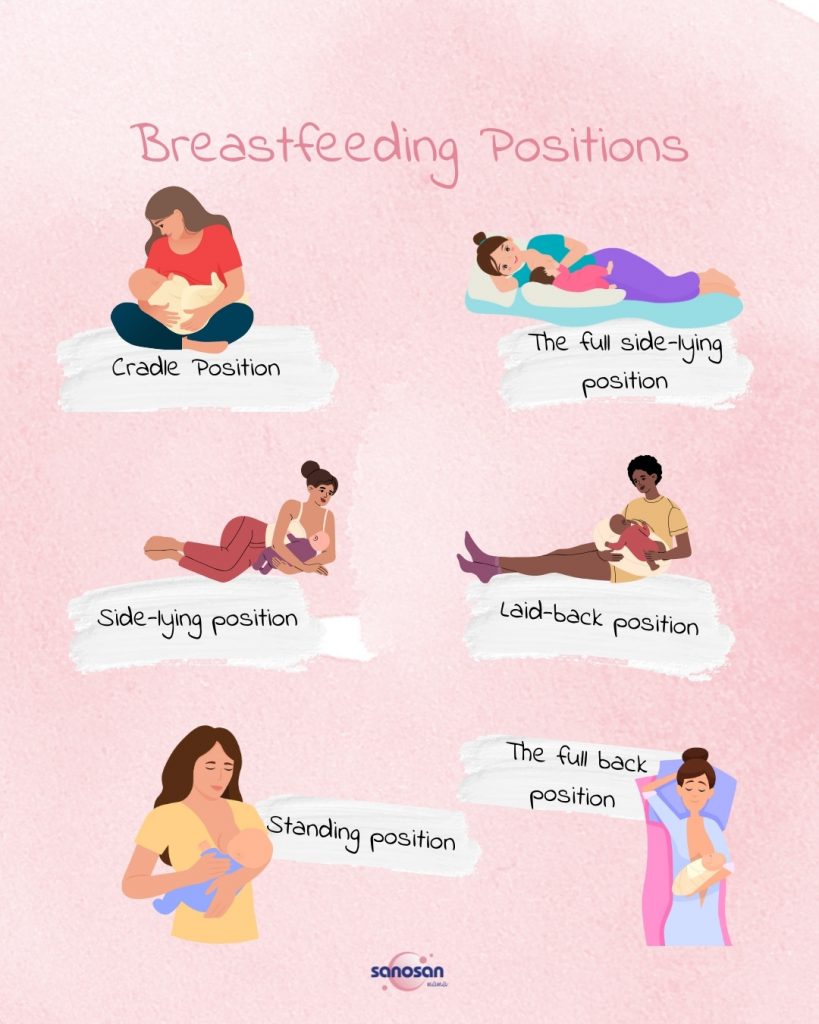From cradle position to supine position: find your breastfeeding position
Breastfeeding is a very special time when you and your baby form a close bond. Every mom has her own way, and finding the right breastfeeding position can make a significant difference. To help you discover the most comfortable position for you and your baby, we would like to introduce you to a selection of positions in this article – from the cradle position, cross position, and back position to the supine position. Because breastfeeding should be one thing above all: a beautiful, relaxed time full of closeness and security.”

Breastfeeding: yes or no?
The decision of whether or not to breastfeed is a very personal one. Breastfeeding offers numerous benefits for both you and your baby: breast milk provides all the necessary nutrients and strengthens your baby’s immune system, reducing the risk of infections, allergies, asthma, and diabetes. For mothers, breastfeeding promotes faster uterine recovery after birth and reduces the risk of breast and ovarian cancer, as well as osteoporosis and cardiovascular diseases. Additionally, breastfeeding strengthens the bond between you and your baby through close skin contact and the hormone oxytocin, which is released during breastfeeding.
However, breastfeeding is not obligatory. If you choose to bottle-feed, there are also advantages. Bottle-feeding can involve the father in feeding the baby, giving you as the mother some relief. Additionally, bottle formula can be tailored to meet specific needs of the baby, such as allergies or lactose intolerance. It’s important that you don’t feel pressured and that you make the best decision for you and your baby.
An overview of different breastfeeding positions
If you decide to breastfeed, there are many different positions you can try. Here, we’ve compiled a list of the most common and well-proven breastfeeding positions:
Cradle position
The cradle position is one of the most well-known breastfeeding positions and provides an intuitive way to breastfeed your baby. In this position, you sit upright and hold your baby in your arm, with the baby’s head resting on your forearm or in the crook of your arm. The baby’s body lies close to your belly. It’s important that the baby is at breast height to allow for easy latching. The free hand can be used to support the baby. A nursing pillow can make breastfeeding in the cradle position even more comfortable.
Cross position
The cross position is similar to the cradle position but offers additional support for the baby. In this position, you sit upright and hold your baby with the opposite hand to the breast from which it is feeding. This supports the baby’s neck and shoulders. This breastfeeding position is especially useful if your baby has trouble latching onto the nipple, and it allows you to better shape the breast with your free hand.
Back position
The back position, also known as the “football hold,” is ideal for mothers who have had a cesarean section, are breastfeeding twins, or have large breasts.
In this position, you hold your baby to the side under your arm, similar to holding a football, with the baby’s head near your breast. The baby’s back and shoulders are supported by your hand or arm. This football hold is particularly helpful for newborns, premature babies, and babies with feeding difficulties, as it gives you good control over the baby’s support and allows you to clearly see if your baby is latched on correctly. Additionally, this position makes it easier for the baby to breathe, as the nose is not pressed into the breast but remains free. This is particularly helpful for babies who have trouble coordinating sucking and breathing.
Supine position: breastfeeding position lying down
In the supine position, you can place your baby on your belly or beside your breast while lying down. The supine breastfeeding position is often the first one mothers try immediately after birth. It promotes milk flow through gravity and strengthens the bond between you and your baby. It is particularly suitable for babies who have difficulty latching onto the nipple and for mothers with larger breasts. This lying position is also excellent for nighttime breastfeeding when you want to rest.
Side-lying position
The side-lying position is a relaxed posture, ideal for nighttime or when you want to rest. Lie on your side while your baby also lies on its side, with the nipple within reach. This breastfeeding position allows you to lean back and enjoy contact with your baby without having to exert yourself too much. It is especially helpful after a cesarean section. Make sure your baby is safe and comfortable and can easily reach the nipple.
Upright or “Koala” hold
In the upright or “Koala” hold, you sit on a chair or armchair, with your baby seated on your thigh, slightly angled in front of you. Your baby’s head is near your breast while the body extends across your thigh. This breastfeeding position offers good control and support for the baby and is particularly comfortable after a cesarean section, as it spares the abdominal area.
Four-point position
This breastfeeding position is useful for dealing with blocked milk ducts and other breastfeeding issues. You position yourself on all fours, with your hands and knees on the floor, keeping your back straight. Your baby is placed underneath you so that it can reach up to the breast. This position can help promote milk flow and reduce pressure on the abdominal area, making it an excellent breastfeeding position for sore nipples and bloating.
Breastfeeding while standing
Breastfeeding while standing can be particularly convenient when you’re on the go. In this position, you hold your baby close to your body with one or both arms. The baby’s head should be at breast height. This breastfeeding position requires some practice but offers flexibility as you can move around freely. Make sure to stay relaxed to avoid back pain or tension.
Freestyle position
Here, you can choose the breastfeeding position that is most comfortable for you and your baby, without being tied to a standard position. You can draw inspiration from classic positions and adapt them as needed, for example, breastfeeding while lying down or standing up.
Changing breastfeeding positions
Switching breastfeeding positions can make the breastfeeding experience more comfortable for both you and your baby. It helps ensure that all milk ducts are emptied evenly, reducing the risk of blocked milk ducts and mastitis. For your baby, it supports motor development by encouraging them to hold and move their head and neck in different angles. Trying out various positions can also help improve milk intake and establish a comfortable breastfeeding routine for both of you.
Tips for breastfeeding in public
Breastfeeding is one of the most natural and ancient forms of nourishment, so there is absolutely no reason to feel ashamed. You decide how and where you breastfeed. If you prefer more privacy, you can drape a light nursing cover or scarf over your shoulder and find a quiet corner or designated nursing areas. Many public places, such as cafes or shopping centers, now offer special nursing rooms that can provide you with extra comfort.
- Nursing Clothes: Nursing bras and tops are not only practical but also comfortable. They provide quick and discreet access to the breast without needing to undress completely. Look for soft and breathable materials to ensure extra comfort.
- Nursing Accessories: A light nursing pillow can not only improve your posture but also help keep your baby in the optimal position. It can also serve as support when sitting at a table or in a chair.
- Breastfeeding Positions: The cradle position, cross position, and back position are particularly well-suited for breastfeeding in public, as they are easy to implement and comfortable. The cradle position offers a good view of your baby and is convenient when sitting at a table or in a chair. The cross position provides extra support, which can be especially useful during public breastfeeding moments. The back position can be helpful when sitting on a bench or in a comfortable armchair.
Frequently asked questions about breastfeeding positions
What should I do if I have trouble latching my baby?
If your baby has difficulty latching onto the nipple, try a different breastfeeding position or use nipple shields to make the nipple more accessible. Patience and regular practice are important.
How can I avoid pain while breastfeeding?
Make sure your baby is properly latched. Ensure that your baby has the nipple deep enough in their mouth and not just the tip. A deeper latch reduces pressure on the nipple. Also, check that both you and your baby are in a comfortable and supportive position. If your nipples are sore and irritated, a soothing nipple salve or a few drops of breast milk gently massaged in after breastfeeding can help. Click here to learn more about sore and painful nipples from breastfeeding.
Breastfeeding is a unique experience that connects you and your baby. Finding the right breastfeeding position can make this special time even more enjoyable. It’s completely okay if it takes some time to find the right position, and it’s perfectly fine if everything isn’t perfect at the beginning. The most important thing is that you both feel comfortable – trust your instincts! If you need advice, don’t hesitate to seek support from your midwife, doctor, or healthcare provider.







Comments (0)